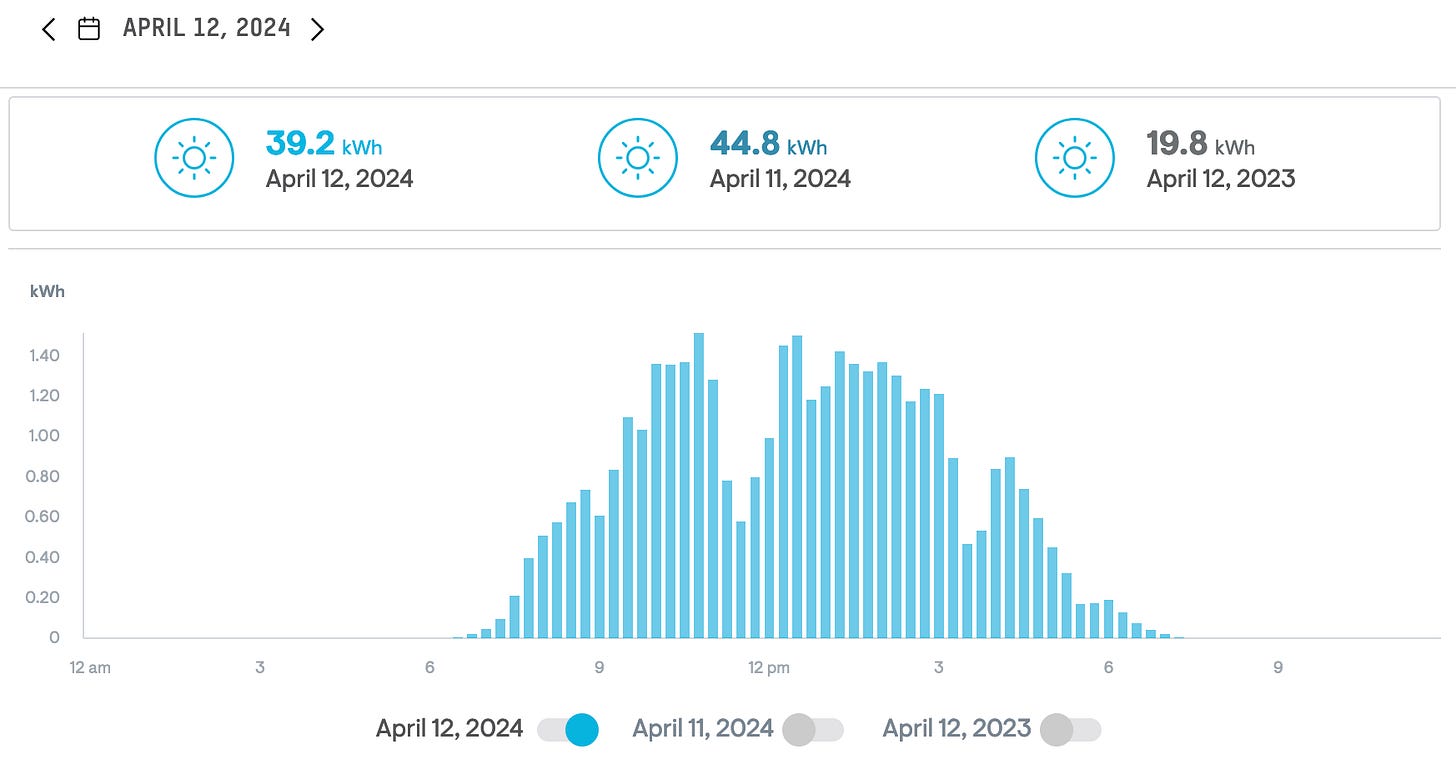How the Eclipse Affected Solar Production
And how the power keeps flowing even when the sun goes out
Without intending to, I’ve been making all my Earth Month posts about clean energy. If that’s not your thing, rest assured — next month, I’ll be back to my usual more philosophical leanings. Though they may still creep in here and there this month, too.

I’m a bit bummed I didn’t make the trek to see the recent eclipse somewhere along the path of totality, as crazy as the crowds would have been. Accounts like this one by
, plus the NASA live feed, helped me experience it vicariously, but they also made me wish I’d been there in person.The 35% eclipse we got in Oakland couldn’t measure up to that. Still, we had a clear, sunny day here, after an unusually cold and wet winter, and Rafael and I both had a break from meetings. So we stepped outside for a few minutes to catch a glimpse of the cool shadows and view the eclipse through a pinhole.
Solar production at our house
That was a fun Monday interlude. But the day was still so bright that it didn’t occur to me till later to check the effect this small eclipse had on our solar production.

As these charts show, our production fell from 5.3 kilowatts (kW) to 4.1 kW during the eclipse. That’s not a huge dip, but it’s noticeable — and it was surprising to me, given that we didn’t notice the sunny day getting any dimmer when we were out there. Time of day is also a big factor in solar production, as you can see in the charts; our production got as high as 6.1 kW that same day. (Our production on April 8 last year was much lower because we’ve doubled the size of our system since then.)
To put this in perspective, here’s our production on a recent partly cloudy day — all over the place:
So the eclipse didn’t affect our solar production as much as cloudy weather does.
Beyond our house
What about the rest of California? You can look up California’s power production for any day at the California Independent System Operator (CAISO), which manages our grid. In their April 8 chart you can see a similar dip for solar, which accounts for a good chunk of our state’s energy during the day.

What made up for this gap on Eclipse Day? Not fossil gas (sorry, there’s nothing natural about our use of this fossil fuel). It was batteries that filled in for the solar dip. That’s good news for our grid. Batteries can jump into action instantly when they’re needed, providing a much better power option than the polluting, gas-powered “peaker plants” that utilities have recently been relying on to address energy shortfalls.
This is just California, and just a partial eclipse. How did locations in the path of totality fare? Solar capacity in the U.S. has tripled since the last total eclipse, so any reductions in solar generation are felt more than they used to be. Texas, which is now producing more power from solar than from coal, is acting like it’s trying to catch up with top solar state California. But the solar dip on Eclipse Day did not take down the grid, though solar production dropped from 13.5 gigawatts (GW) at noon to 0.8 GW at 1:30.

Though you can see a small rise in energy storage at the time of the eclipse, most of the power shortfall was covered by ramping up gas, still the state’s top energy source. However, Texas has been rapidly increasing deployment of grid-scale energy storage, so that will likely play a bigger role in the future.
As for the rest of the country, here’s a cool model by the National Renewable Energy Laboratory (NREL) showing the expected eclipse effects:
Preparing for eclipses and other events
Other factors, like clouds, can affect solar production — whether or not there’s an eclipse. Extreme weather events and wildfires play a role, as we saw in California in September 2020.
When solar production goes down and/or energy demand goes up, we have to rely on other power sources. Recently, that’s meant gas, but increasingly, it’s coming to mean energy storage and demand response.
Though batteries didn’t play a starring role in Texas last week and had only a supporting role in California, they were put to a much bigger test during last summer’s heat waves — a test they passed with flying colors, saving the California and Texas power grids from collapse. Another rising star is demand response, which means balancing the demand on power grids by incentivizing customers to shift their electricity use (demand) to times when more electricity is being produced or demand is lower.
You’ll be hearing more about energy storage and demand response — especially in states like California, where renewables just met 100% of energy demand for 30 out of 38 days (for 1/4 hour to 6 hours each day). You probably didn’t hear about that, unless you follow Mark Jacobson, a Stanford professor who believes we can get to 100% renewables with the technology we have today. He’s been keeping track of the state’s energy demand compared to our renewable energy supply, and even he has been blown away by recent trends.
Jacobson’s vision of 100% renewables is achievable now, and it will become all the more feasible as energy storage and other technologies improve. Batteries today are showing that they can already step in when needed to store excess power, and dispatch it later when the sun isn’t shining or the wind isn’t blowing.
So if you’re worried that all those intermittent renewables will take down our grid, you can rest easy. When paired with batteries, and especially when energy sources are distributed rather than centralized, renewables make our grid stronger and more resilient. Even during a total eclipse of the sun.






